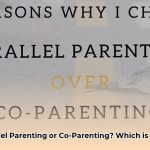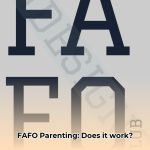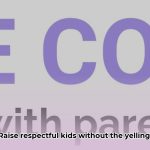Parenting can feel like navigating a minefield of conflicting advice. One moment, experts recommend hovering; the next, they suggest letting kids explore freely. FAFO parenting, short for “f*ck around and find out,” proposes a different approach: allowing children to learn from the natural consequences of their actions. This comprehensive guide explores FAFO parenting, examining its principles, benefits, drawbacks, and practical application, helping you decide if it’s right for your family.
Understanding FAFO: Letting Life Be the Teacher
FAFO parenting has sparked considerable debate. This approach, emphasizing natural consequences over direct intervention, might appear harsh. However, at its core, FAFO empowers kids to learn from the real-world outcomes of their choices. It’s about letting life be the teacher.
Instead of shielding children from every misstep, FAFO parents create opportunities for them to experience the natural ripple effects of their actions. Forget your coat? You might feel cold. Didn’t finish your homework? Your grade might suffer. These experiences, proponents suggest, can be valuable teaching moments, fostering self-reliance, problem-solving, and a deeper understanding of cause and effect.
Crucially, FAFO parenting isn’t about neglecting children. It requires parental discernment and clear communication. A scraped knee after a tumble? Probably a FAFO moment. Darting into traffic? Absolutely not. The line between a learning experience and a potentially harmful situation demands careful consideration.
Weighing the Pros and Cons of FAFO
Like any parenting style, FAFO has potential benefits and drawbacks. Careful consideration is essential before adopting this approach.
Potential Benefits
- Increased Self-Reliance: Experiencing consequences can empower children to take ownership of their choices and foster independence.
- Enhanced Problem-Solving Skills: When not constantly rescued, kids develop creative solutions, building resilience and resourcefulness.
- Developed Personal Responsibility: Understanding the link between actions and outcomes encourages accountability.
Potential Drawbacks
- Risk of Emotional Distress: Some natural consequences can be emotionally challenging. Parental sensitivity is crucial.
- Possible Exposure to Danger: Safety remains paramount. FAFO isn’t appropriate for situations with significant risks.
- Potential for Misinterpretation: The hands-off aspect can be mistaken for neglect. Open communication with your child and others is vital.
Putting FAFO into Practice: A Step-by-Step Guide
FAFO requires careful planning and consistent communication. Here’s a practical guide:
- Establish Clear Expectations: Ensure your child understands what’s expected before letting natural consequences unfold.
- Choose Your Battles: Not every misstep is a FAFO moment. Focus on situations where natural consequences are safe and effective teaching tools.
- Offer Support (Not Rescue): Maintain empathy and provide guidance after the consequence. A listening ear and encouragement can make all the difference.
- Be Consistent: Inconsistency can confuse children. Maintain a steady approach for effective learning.
- Adapt as Your Child Grows: Adjust your FAFO strategy based on your child’s age, maturity, and individual needs.
FAFO in Action: Real-World Examples
- Forgotten Homework: Instead of reminding your child repeatedly, allow them to experience the natural consequence of a lower grade. Later, discuss how they can avoid this in the future.
- Lost Toy: If your child consistently misplaces toys, resist the urge to replace them immediately. The temporary loss might encourage better organization habits.
Comparing FAFO with Other Parenting Styles
FAFO draws inspiration from several parenting philosophies, primarily authoritative parenting, which emphasizes clear expectations, warmth, and open communication. However, FAFO leans more heavily on self-reliance. It contrasts sharply with permissive parenting, which is often characterized by leniency and minimal intervention. Similarly, it differs from authoritarian parenting, which prioritizes strict obedience and may not offer opportunities for learning from natural consequences. Some research suggests that authoritative parenting is frequently associated with positive outcomes for children. However, it is essential to note that research in this domain is constantly evolving and the “ideal” parenting style can depend on both individual child and family dynamics.
| Parenting Style | Characteristics | FAFO Elements (if applicable) |
|---|---|---|
| Authoritative | Warmth, clear expectations, open communication | FAFO can complement this style by reinforcing expectations with natural consequences. |
| Permissive | Lenient, fewer rules, less enforcement | FAFO’s hands-off approach might resemble permissiveness, but the emphasis on consequences provides structure. |
| Authoritarian | Strict, high expectations, punitive measures | FAFO contrasts with this style, emphasizing learning from experience rather than punishment. |
Addressing Concerns: Is FAFO Neglectful?
One frequent criticism of FAFO is the potential for misinterpretation as neglect. The key difference lies in intent and follow-up. Responsible FAFO involves careful observation and willingness to intervene in unsafe or emotionally overwhelming situations. It’s about providing a safety net, not abandoning children to their fate.
Tips for Implementing FAFO
- Start Small: Begin with low-stakes situations to allow both you and your child to adjust to the approach.
- Communicate Clearly: Explain why a consequence is occurring, connecting it directly to their actions.
- Stay Engaged: Observe your child’s reaction and offer support without rescuing them.
- Be Flexible: FAFO isn’t one-size-fits-all. Adapt your approach based on your child’s individual needs and the specific circumstances.
FAFO and Long-Term Impact: Fostering Resilience and a Growth Mindset
While some might worry that FAFO cultivates a fear of failure, proponents argue that it encourages resilience and a growth mindset. By experiencing setbacks in a supportive environment, children learn to view mistakes as opportunities for learning and development.
FAFO and Child Development: An Ongoing Conversation
Research in child development constantly evolves. While some studies may suggest that a more balanced approach, integrating authoritative parenting techniques, is ideal, the most effective parenting style likely varies depending on individual circumstances. Parents should stay informed, remain adaptable, and prioritize their child’s specific needs.
Conclusion: FAFO as a Tool, Not a Rule
FAFO parenting, while controversial, offers an alternative approach to raising self-sufficient and responsible children. It’s not a magic bullet, but a tool that, when used thoughtfully and with careful consideration, can contribute positively to a child’s development. The goal is to find a balance between allowing children to learn from their mistakes and providing the guidance and support they need to thrive. Remember, parenting is a journey, not a destination.
- 200+ Co-Parenting Quotes: Inspiration, Humor, and Wisdom for Every Stage - February 5, 2025
- Parenting Teens with Love and Logic: A Practical Guide to Raising Responsible Adults - February 5, 2025
- Indiana Parenting Time Guidelines PDF (2024): Download & Understand - February 4, 2025
















